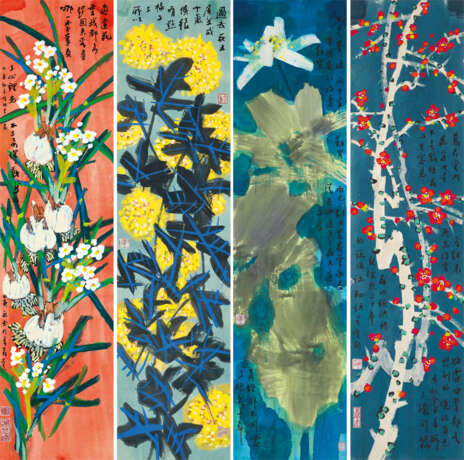ID 1089178
Lot 1030 | HUANG YONGYU (1924-2023)
Valeur estimée
HKD 600 000 – 800 000
Flowers of Four Seasons
A set of four scrolls, mounted and framed, ink and colour on paper
Each scroll measures 138 x 34 cm. (54 3⁄8 x 13 3⁄8 in.)
(4)Inscribed and signed, with nine seals of the artist
Dated spring, yiyou year (2005)
Further details
From Fenghuang County to the Hall of Ten Thousand Lotuses: Paintings by Huang Yongyu
Born in 1924 in Fenghuang County, Hunan Province, Huang Yongyu was one of the most groundbreaking and multi-talented modern artists, widely known for his ink-wash paintings, woodblock prints, and literary works. Coming from an impoverished background, he worked in various professions and wandered to different places since the age of thirteen to make a living during the tumultuous wartimes.
He first started creating woodblock prints at the age of sixteen, earning his first income when attending the Jimei School in Fujian Province. In 1948, he moved to Hong Kong and quickly gained local recognition after his first solo exhibition. He then worked as an arts editor alongside Jin Yong for Ta Kung Pao, wrote screenplays for films, and befriended many figures in Hong Kong’s cultural circle, such as James Wong Jim. He moved to Beijing in 1953 after being referred by his uncle, the famed writer Shen Congwen, as the youngest professor at the Central Academy of Fine Arts.
Huang Yongyu gained initial fame through his print series Ashima (1957) and Spring Tide (1961) for its strong folk influences and bold style, but he never stopped pushing the boundaries of his practice. Whilst living alongside other emerging artists in Chinese paintings, such as Li Kuchan and Li Keran, Huang Yongyu started exploring and experimenting with ink and oil paintings. Since the seventies, he produced many colored ink paintings with subjects ranging from landscapes, flowers, figures, caricatures, and birds, often accompanied by inscriptions with historical allusions and playful messages. During the Cultural Revolution, his painting Winking Owl (1973) caused controversy, but he regained his reputation by creating the first zodiac stamp for the Year of the Monkey in 1980, which would later be the most sought-after postal stamps in China. Huang returned to Hong Kong in 1988 and continued to hold exhibitions both at home and abroad. He spent his final years in the suburbs of Beijing, naming his self-designed residence and studio the Ten Thousand Lotus Hall—a reference to his lifelong love for lotus flowers.
Aside from being known as an artist, Huang was also a bestselling author and prolific writer who had published essays, picture books, autobiographies, and poems. His literary talent and humorous personality are evidenced through his extensive but insightful inscriptions that complement the artworks. Before he passed away in 2023, Huang was once again commissioned to design special stamps for the Year of the Rabbit, which later sold out quickly.
Christie’s fall auction presents some of the most well-known themes and personal moments in Huang Yongyu’s extensive oeuvre. From his famed lotus flowers and humorous rabbits to works that commemorate his reunion with his childhood friend Su Tu, each work celebrates an important chapter in Huang Yongyu’s itinerant life and offers a glance of his extraordinary personality.
| Artiste: | Huang Yongyu (1924 - 2023) |
|---|---|
| Style artistique: | Art moderne, Art contemporain |
| Artiste: | Huang Yongyu (1924 - 2023) |
|---|---|
| Style artistique: | Art moderne, Art contemporain |
| Adresse de l'enchère |
CHRISTIE'S 18 Chater Road Central Hong Kong Hong Kong | ||||||||||||||
|---|---|---|---|---|---|---|---|---|---|---|---|---|---|---|---|
| Aperçu |
| ||||||||||||||
| Téléphone | +85227601766 | ||||||||||||||
| Fax | +852 2760 1767 | ||||||||||||||
| Conditions d'utilisation | Conditions d'utilisation | ||||||||||||||
| Heures d'ouverture | Heures d'ouverture
|















